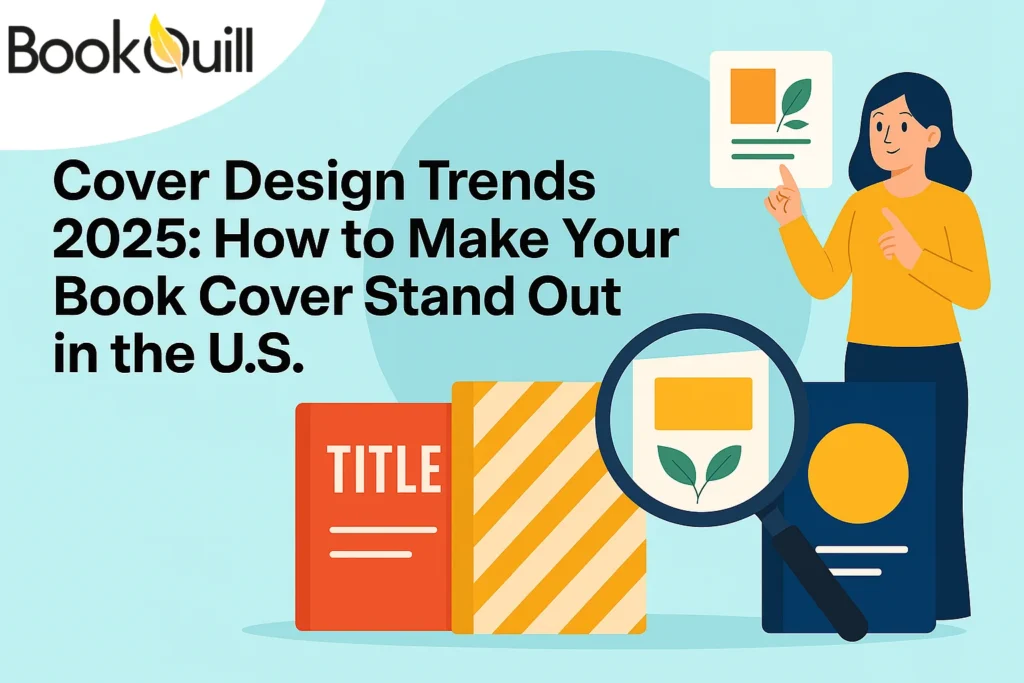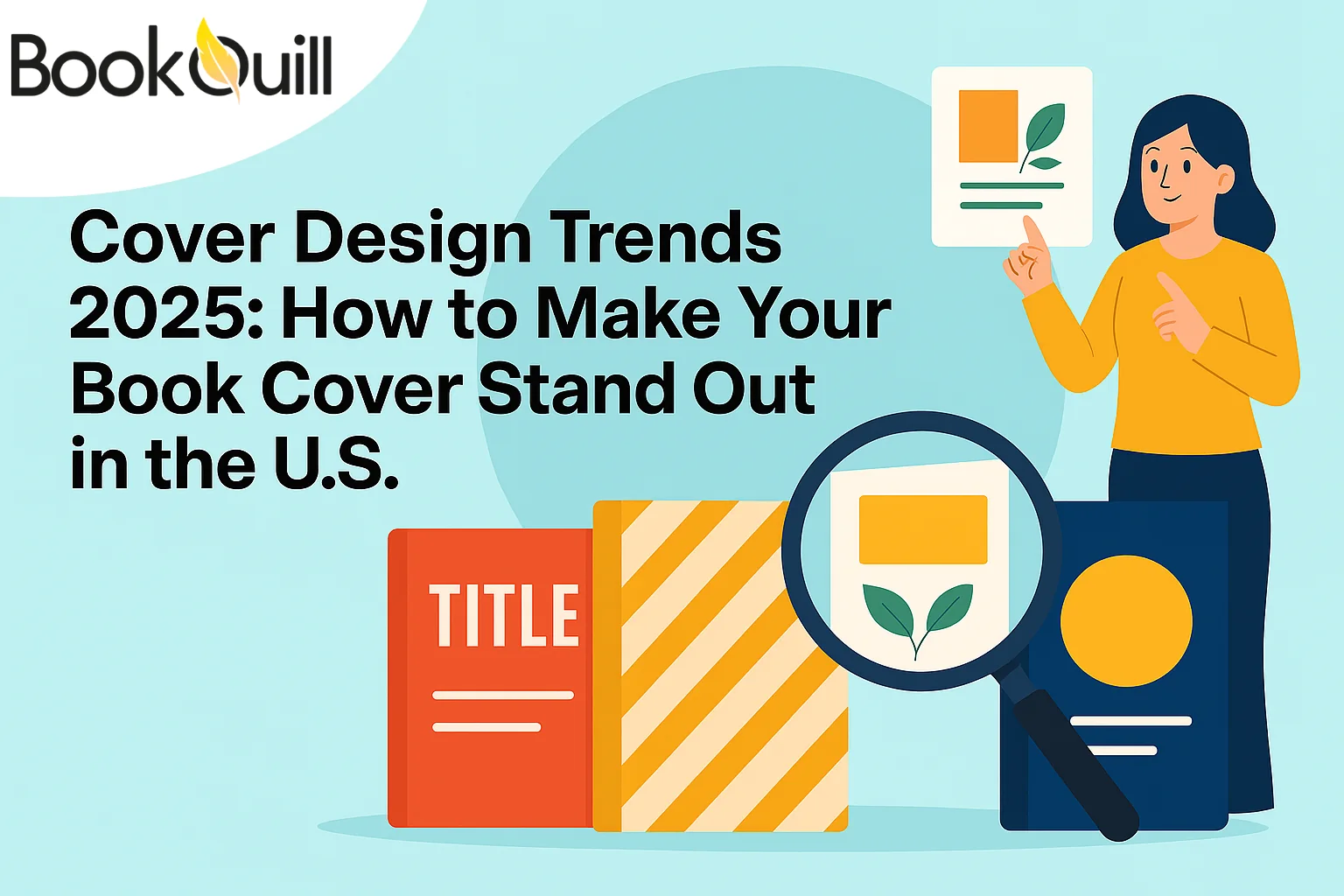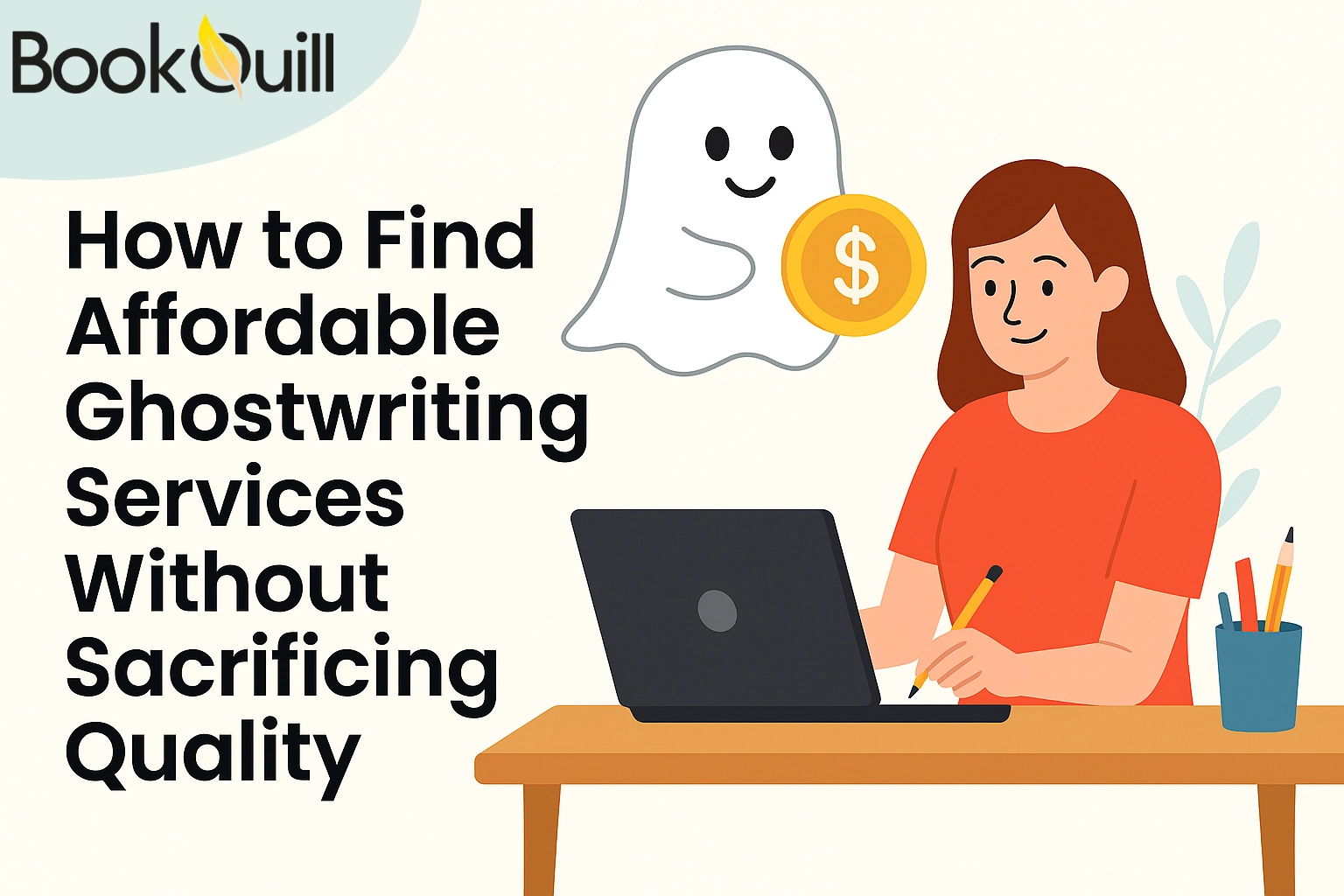Table of Contents
Explore Blogs
Trending on Ebook
Cover Design Trends 2025: How to Make Your Book Cover Stand Out in the U.S

In the sea of thousands of books competing for attention on bookstore shelves, on Amazon, and on social media, your cover is your first hello. It makes them take a closer look at the genre and then buy it.
According to Statista’s 2025 U.S. Book Market Report, the American book industry generates over $25 billion annually, with thousands of new titles released each year. That intense competition makes standout cover design a crucial factor in capturing readers’ attention.
In the U.S. market, where trends shift fast and tastes are diverse, knowing cover design trends for 2025 isn’t just nice to have; it’s survival. Let’s explore what’s trending now in book covers.
Key Takeaways
- Visual Boldness Is In – 2025 book covers are all about contrast, bold color palettes, and expressive typography. Simplicity with strong visual identity remains key to capturing readers scrolling fast through online bookstores.
- Illustration Adds Uniqueness – Custom artwork can elevate your cover from “good” to unforgettable. Working with illustrators through illustration services ensures high-quality visuals that align with your story’s tone.
- Typography Drives Emotion – Fonts set the tone. Oversized serif fonts, artistic hand-lettering, or clean sans-serifs are dominating 2025’s trending book covers. Great typography instantly tells readers whether your book is thrilling, romantic, dark, or hopeful.
- Market Testing Matters –Run A/B tests on social media or via ads to see which cover design attracts clicks. Even subtle changes in color or layout can impact reader response, especially in the competitive U.S. market where readers make split-second decisions visually.
Why Trends Matter and Where to Draw the Line
1. Signal Matching
In many genres, readers expect certain visual cues. If you break too far from genre norms, your cover might “read wrong” (e.g., a fantasy novel with a minimalist white layout might confuse readers).
2. Visual Differentiation
But at the same time, if your cover is too similar to the others, readers scroll past. You want a “twist” or hook that turns heads.
3. Digital-First Reality
Many readers will see your cover as a tiny thumbnail on Amazon, social media ads, or book catalogs. So, your cover must work at small sizes.
4. Branding & Series Potential
If you plan more books, your covers should hint at consistent branding or a visual thread so readers can recognize your kind of book.
Thus, a smart cover picks up on the spirit of the trend without being derivative. Trends are a launching pad, not a cage.
Top Cover Design Trends for 2025 in the U.S. market
Let us walk you through the biggest trends that are shaping cover design in 2025, especially in the U.S. indie/commercial space.
1. Bold, Vivid Colors & High Contrast
You see this everywhere. Covers opting for deep, saturated hues, neon, electric, jewel tones, are being used to cut through visual noise. Designers are also leaning into high contrast combinations, such as dark/light, and color pops. But why? Because on a digital feed or Amazon grid, muted covers often disappear.
Bold color shouts, “Look at me.” Context also matters. The color palette should still match the mood or genre. A thriller might use a dark, moody contrast; a memoir could use a striking accent color.
2. Large, Expressive Typography as Focal Point
Typography isn’t just functional anymore — it is the design. Big, expressive fonts, even overlapping or interacting with imagery, are trending. Some covers use minimal imagery and let the title text dominate.
This is partly a practicality: a big, clear title reads better at small thumbnail sizes. But it’s also stylistic: type can carry mood, tension, and personality.
3. Abstract, Symbolic, and Minimal Imagery
Instead of literal photographic images (a person’s face, a house, etc.), many covers are embracing abstract shapes, symbolism, geometric compositions, or minimal line art. They hint, rather than show.
That gives breathing space, helps with versatility across formats (print, ebook, audio), and often communicates more emotionally or conceptually.
4. Collage, Mixed Media, Texture Layering
Some designers are embracing textured layers: a collage of images, cutouts, mixed media, and overlays of textures (paper, paint, photography). This works especially well in literary fiction, memoir, and non-fiction.
When done well, it gives depth and invites the eye to wander, which is engaging. But too much clutter kills clarity, so balance is key.
5. Gothic, Dark Academia, Moody Aesthetics
A subcurrent trend: covers borrowing from gothic, dark academia, classical art, with muted palettes (blacks, deep greens, burgundy) and ornate, evocative touches.
This works especially in literary fiction, fantasy, or any book that wants to evoke introspection or mystery.
6. Eco / Sustainable and Raw Material Textures
Readers are increasingly conscious of sustainability, and that extends to book design. Covers with recycled textures, paper grain, natural tones, and “unfinished” edges or organic elements are becoming more popular.
Also, materials and finishes (matte, soft touch, uncoated paper) that feel natural or tactile are perceived as more premium and trustworthy.
7. Interactive or Digital Augmented Elements
Because we’re in a digital age, there’s room for interactive covers: subtle animations (in e-books or AR), motion graphics, covers that change with lighting or viewpoint, etc. Also, some covers incorporate QR codes or hidden “Easter eggs” that invite readers to scan, unlocking bonus content.
8. Edge Design/Decorative Page Edges
The edges of the pages—or fore-edge art—are getting attention. Painted or decorated page edges, aka “spredges”, are becoming a collectible aesthetic, adding an extra visual surprise. It’s more niche (may cost more in print), but in a U.S. market saturated with collectibles and signed editions, this kind of detail can make a book stand out physically.
9. Generative Design/AI-Assisted Layout
Behind the scenes, designers are increasingly experimenting with AI / generative tools to explore layouts, color combinations, and abstract imagery. Research is showing promising results in supporting creative ideation.
We might not see fully AI-designed covers all altogether yet, but hybrid approaches (designer plus AI as assistant) are trending.
How to Make a Book Cover That Stands Out in the U.S. Market
Now that we’ve covered the trends, let’s talk tactics. How do you take these trends and apply them smartly for your book in the U.S. market?
1. Start by Deeply Knowing Your Target Reader
Before you pick colors or fonts, ask:
- Who is your reader (age, taste, visual sensibility)?
- What covers in that genre are doing well now?
- What visual “signal” is expected (e.g., thriller covers often have darker tones, bold contrast).
Use Amazon, Goodreads, BookTok, and bookstore browsing to collect “cover mood boards.” Use them as a reference—not to copy, but to feel the visual language of your niche.
2. Sketch Multiple Cover Directions
Here’s the truth: your first idea is almost never your best one. It’s the safe version your brain gives you before the real creativity shows up. Try sketching three to five completely different directions. Maybe one that’s minimal, one that’s bold and chaotic, one that’s purely typographic, and one that looks like something your editor might love and hate at the same time. That’s usually where the magic hides.
And if you’re staring at your screen, wondering if your stick figure counts as a design draft (no judgment), get some help from the pros. Platforms like 99designs let you run contests or hire designers who live and breathe book covers. You’ll get multiple concepts from real artists who understand the trends, without spending months chasing inspiration on Pinterest.
3. Prioritize Clarity, Legibility & Readability
No matter how creative, your title and author name must read at thumbnail size. That often means bold type, avoiding too many competing visual elements, and good contrast. Always test your cover design at a small scale (100px wide or so).
4. Add One Hook or Visual Twist
To avoid blending in, include one element or effect that gives your cover personality. Maybe a sliver of abstract paint, a subtle texture, a custom illustration detail, or a striking type treatment. Even small things can shift a cover from just nice to memorable.
5. Use Custom Illustration Selectively
When you commission an illustration (versus stock photography), your cover can be more unique and expressive. But illustration must align with the concept, genre tone, and readability. That’s where you need professional book illustration services. Use those terms when you’re sourcing illustrators or firms, to find ones skilled in expressive, market-aware covers.
6. Unify Your Color, Type, And Visual Hierarchy
Pick a limited color palette (2–3 colors + neutrals), a type hierarchy (title, subtitle, author), and a layout that balances. Make sure your visual flow leads the eye: title first, visual or illustration second, author name last.
7. Consider Print, Ebook, Audio, And Promotional Uses
Your cover won’t just live on a print book; it will appear as a square thumbnail, in ads, in banners, on social media, and on audio platforms. So the design must adapt across formats. That means sometimes designing alternate “banner” versions of the cover, or having a stack of images / cropped variations.
8. Pay Attention to Finishing Details
Foil stamping, embossing, spot gloss, matte or soft touch, die cuts, and edge painting, again, spreads can raise your book’s perceived value. But be thoughtful — too much can clutter or increase cost disproportionately.
9. Test with Real Readers & Use A/B
If possible, run A/B cover tests (on social media ads, or with email lists) to see which cover concept gets more clicks/engagement. Even small shifts (color, font weight) can change performance. Use that data to inform your final pick.
10. Stay Slightly Ahead, Not Behind
Trends change. A cover that looks too of-its-time might date fast. Try to pick elements that feel contemporary but avoid overly faddish gimmicks.
Sample Cover Concepts
Let us sketch three hypothetical cover direction ideas to illustrate how these trends and tactics might combine:
1. Minimal + Bold Typography
- Title in huge, custom serif/sans serif type, in white on a deep emerald background
- Tiny abstract line drawing (e.g., of a leaf, or a symbolic shape) at the bottom
- Subtle texture on the colored background
- Use spot gloss on the title or a matte finish
2. Abstract Symbolism + Texture Layers
- A collage of faint photographic textures (paper grain, faint hands, torn edges) blended together
- A single symbolic silhouette (e.g., a bird, a door, a horizon) overlayed in one accent hue
- Type set in bold sans serif in white or high contrast
- Faded, muted palette with one accent pop
3. Eclectic / Mixed Media Illustration
- Commission a custom line illustration (e.g., of a person or scene), but simplify/stylize it
- Place it somewhat off-center or partially cropped
- Use color blocking behind the illustration
- Title text wraps partially around or intersects the illustration
- Use a slight texture or paper grain finish
From those, you could test which resonates most with your target audience via A/B.
Mistakes & Pitfalls to Avoid
- Overcomplication: Too many visual elements, patterns, or textures can muddy your message and reduce legibility.
- Ignoring Thumbnail View: If the title disappears at 100px wide, it fails. Always check small-scale versions.
- Using Generic Stock Imagery without Reworking: If it looks obviously “stock,” readers may distrust it.
- Mismatch of Tone: A whimsical, overly bright cover for a dark thriller will repel the right readers.
- Ignoring the Back Cover & Spine: In physical print, spine and back cover (and the way they flow together) matter. Many readers glance at spines in bookstores.
- Too Many Design Gimmicks: Effects like double exposure, overlaid glitch effects, or heavy filters are tempting, but often date quickly.
- Neglecting Production Constraints: Some finishing features (foils, emboss, die cuts, edge painting) cost more or require premium printers — make sure your budget supports what you choose.
Steps to Production Workflow
Here’s a possible workflow you and your designer/illustrator can use to produce a cover that’s trend-aware, functional, and marketable in the U.S.:
- Collect 20+ book cover ideas you like (genre adjacent)
- 3-5 radically different directions
- Pick 2 or 3 directions and mock them up more fully
- View mockups at thumbnail, banner, and social sizes
- Gather feedback or run micro a/b tests
- Finalize color palette, type, and illustration
- Design back cover, spine, and consider wrap/spread/flaps
- Choose finishing & print specs (coating, paper, embossing)
- Generate alternate crop versions (square, banner, mobile)
- Export to all needed formats (print-ready files, ebook covers, promotional sizes)
Along the way, ensure your top book illustration service collaborates well with your designer so illustrations integrate cleanly into the layout.
U.S. Market Nuances & Tips
Since your goal is the U.S. market, a few extra notes:
- Cultural References: Be careful with symbols or visuals that might mean something different to U.S. audiences (e.g., American icons, slang imagery). Test clarity with U.S.-based readers where possible.
- Typography Familiarity: U.S. readers are used to certain type styles in genres (e.g., thriller, romance, self-help). Don’t stray so far that the book “looks like the wrong genre.”
- Competitive Awareness: Use Amazon search in your genre, sort by bestsellers, and screenshot the top 20 covers. Identify color, layout, and text weight trends.
- Promotional Flexibility: Your cover must adapt well to social ads, banner ads, email headers, etc. Many U.S. authors run heavy social marketing.
- Retail Constraints: If your book might be sold in physical U.S. bookstores, ensure the spine legibility, back cover copy layout, and barcode placement are standard.
- Collectibility & Special Editions: U.S. readers often respond to special editions (foils, signed, embossed, special edges). If budget permits, plan for a premium variant with finishing touches like spredges, foils, or embossing.
Conclusion
In a crowded U.S. market, your book cover is more than packaging; it’s positioning. The 2025 playbook is simple: lead with bold color and clear typography, add a distinctive hook, often a thoughtful illustration, and design for thumbnail first. Use trends as guardrails, not shackles, and validate choices with quick A/B tests.
Plan the full system, such as spine, back, audio, and promo crops. If budget allows, elevate print with one premium finish (foil, emboss, or sprayed edges). Most of all, align every visual decision with your reader’s expectations and your genre’s signals. Do that, and your cover won’t just look current, it’ll convert. Ready to move? Shortlist concepts, test, iterate, and ship the strongest version with confidence.
FAQS
Q.1. Why should I hire professional illustrators for my book cover?
Hiring experts through the best book illustration services ensures your cover is unique, marketable, and aligned with your genre. Professionals know how to balance illustration, color, and typography for both digital and print formats, giving your book a polished, bookstore-ready appearance.
Q.2. What if I only need a partial illustration for my cover?
You don’t have to go full-art. Many authors commission symbolic or minimal illustrations. A hand, a moon, or an abstract pattern to personalize their design. A book illustration services website can connect you with artists who create flexible, partial illustrations that fit any budget or concept.
Q.3. How do I choose a reliable book illustration services website?
Look for portfolios that show style variety, client reviews, and previous publishing work. A trustworthy book illustration services website should showcase clear pricing, transparent timelines, and communication options so you can collaborate easily with illustrators who understand your story’s visual tone.
Q.4. Are custom book illustration services expensive?
Costs vary based on complexity and experience, but book illustration services often pay for themselves through higher engagement and perceived value. A unique illustration can set your book apart in crowded marketplaces, boosting both visibility and long-term sales potential.
Q.5. Can I combine illustration and photography on my cover?
Absolutely. Many 2025 design trends merge illustration with photography or textures for depth. The key is subtle integration—let one element lead. Professional designers or custom book illustration services can ensure both mediums blend seamlessly without overwhelming the layout or confusing the tone.
Affiliate Disclosure
Note: Some of the links in this post are affiliate links. This means if you click on them and make a purchase, we may earn a small commission at no extra cost to you. We only recommend products and services we genuinely trust and believe will be useful to our readers. Your support helps us continue creating honest, helpful guides like this one. Thank you!
About Author
Hi, my name is Zachary Stone I’m a book marketing nut — or, as I like to call myself, a “Shelf Marketer.” No, I don’t sell wooden shelves; I market the books that are left forgotten on them. If you want your book to be the next bestseller, I am your go-to person. I am here to remind you that it’s not just about writing a great story — it’s about building a buzz among people with great campaigns.






